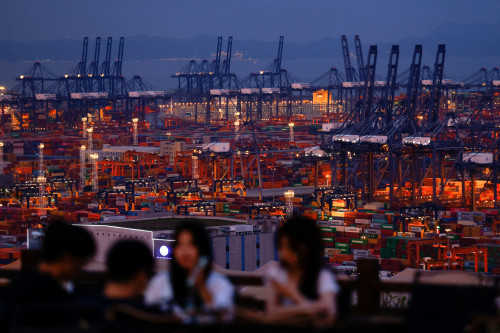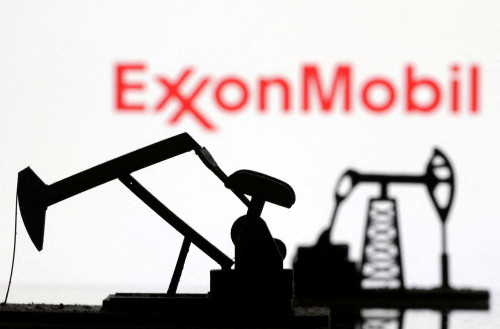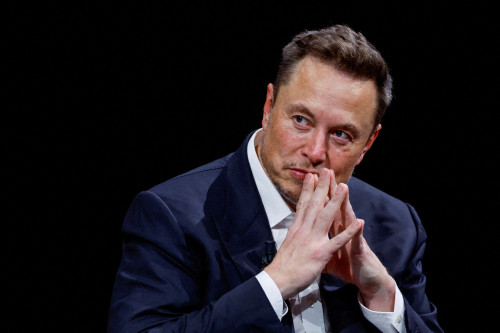By Suzanne McGee
(Reuters) -Investors are hopeful that U.S.-China trade talks this weekend will cool a trade war between the world’s two largest economies and dispel some of the uncertainty clouding financial markets, though few expect a major breakthrough just yet.
U.S. Treasury Secretary Scott Bessent said on Sunday that there had been “substantial progress” in two days of talks between his team and that of Chinese Vice Premier He Lifeng in the Swiss city of Geneva on defusing the standoff. But he offered no details of an agreement reached.
Bessent said he would give more specifics on Monday, while U.S. Trade Representative Jamieson Greer, also at the talks, said the differences between the two sides were not as great as previously thought.
“I’m happy to report that we’ve made substantial progress between the United States and China in the very important trade talks,” Bessent told reporters.
The meeting in Switzerland could mark one of the biggest developments since U.S. President Donald Trump launched sweeping tariffs on April 2, which threw the global trade landscape into chaos and set off extreme market volatility.
“This is the mother of all negotiations,” said Alejo Czerwonko, chief investment officer, Emerging Markets Americas, at UBS.
“There are hundreds of billions of dollars of trade on the line, a 145% tariff on Chinese exports that amounts to some sort of de facto embargo and grievances that extend well beyond trade.”
U.S. President Donald Trump said late on Saturday after the first day of talks that the two countries had negotiated “a total reset … in a friendly, but constructive, manner.”
He added that “great progress” was made, without elaborating.
Recently, investors have expressed optimism that the worst-case trade scenarios would not come to pass, and pointed to signs of de-escalation between the U.S. and China as a reason behind a rebound in equities.
But despite comments by Trump ahead of the talks suggesting a lower level of Chinese tariffs, and a trade deal announced on Thursday between the U.S. and Britain, many market participants said they were not expecting major breakthroughs in the talks.
“We’re still doubtful that direct U.S.-China negotiations will lead to a ‘grand compromise’,” said Thierry Wizman, global FX and rates strategist at Macquarie, in a note to clients.
IMMEDIATE PACT SEEN AS UNLIKELY
Both the U.S. and China may want, or even need, to reach a deal, said Liqian Ren, director of Modern Alpha at WisdomTree Asset Management. At this early stage, however, there seems to be little incentive to do so rapidly, she added.
“Each still wants to see how the other side copes with negative headwinds,” Ren said.
“Right now, the market is maybe a little bit too optimistic in terms of what China and the U.S. can achieve and how fast events will move.”
Trade tensions between the two nations escalated last month, when the U.S. boosted tariffs on all Chinese imports to a whopping 145%, and China then raised levies on U.S. imports to 125%.
On Friday, comments by Trump that an 80% tariff on Chinese goods “seems right” – making his first suggestion of a specific alternative to the 145% levies – created some hope of progress toward resolving the dispute.
The benchmark S&P 500 stock index has already erased the steep losses seen in the immediate aftermath of the tariffs announcement on April 2, although businesses continue to warn investors of their impact, and the uncertainty they create, in earnings-related comments.
The S&P 500 remains down about 8% from its February all-time high and roughly 4% for the year.
Amid the tariff chaos, weak consumer sentiment surveys and other “soft data” have raised concerns about U.S. growth, although most economic data has indicated resilience in the economy.
EYEING MARKET VOLATILITY
Volatility, meanwhile, remains. The Cboe Volatility Index, the options-based measure of investor anxiety, hovered around 22 late on Friday – well below its recent closing high of 52.33 in early April, but above its longer-term median of 17.6.
One of the factors curbing that volatility so far has been the high cost of establishing short positions betting on future market declines, said WisdomTree’s Ren.
“When a single (social media post) from the president can make the market move 10%, it becomes very costly” to establish those positions, Ren said. Equities soared on April 9 after Trump paused many of the heftiest tariffs for 90 days.
Still, markets were poised for more volatility ahead, said Matt Gertken, head of geopolitical strategy at BCA, a macroeconomic investment research firm.
Gertken said the firm’s best advice was to “sell on strength.”
Any signs of progress in the initial discussions would be welcome, and allow China to devote more energy to its domestic economic problems, said Andrew Mattock, a portfolio manager at Matthews Asia.
“To talk about any other scenario, you end up with a lose-lose outcome,” he warned.
TOUGHEST DEAL TO NEGOTIATE
Despite the relatively fast agreement with Britain, Claudio Irigoyen, head of global economics research at BofA Securities, cautioned that other deals would be harder to hammer out, with China being the toughest.
“I can see trade deals coming with India, Japan and maybe South Korea, down the road,” he said. “China – this is the most complicated and will be the last one to come,” in part because the geopolitical relationship is entangled with the trade ties.
Investors are concerned that negative scenarios have not been factored into asset prices and several said the market would probably be content with only modest signs of progress.
“We don’t need happy talk,” said Gertken.
(Reporting by Suzanne McGee in Providence, Rhode Island; Additional reporting by Laura Matthews and Gertrude Chavez-Dreyfuss in New York, John Revill in Geneva and Amanda Cooper in London; Editing by Matthew Lewis, Edmund Klamann and Ros Russell)





